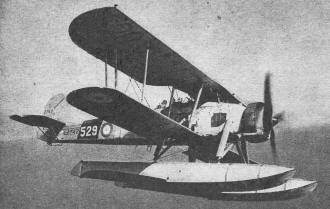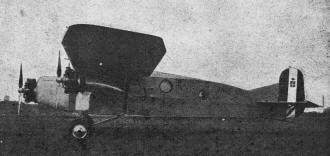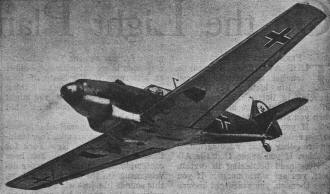|
It's kind of hard to think of a 'modern plane' being something that
was new to the aviation scene in 1942 (1941,
actually, since this is from a February 1942 edition of Flying
Aces). Most likely, when this column was written the
U.S. had not officially been drawn into World War II. Seeing
the Messerschmitt Me. 109 included in the lineup is amazing, especially
the comment about the most recently modified version having a retrofit
with an engine so large that German engineers used heavy steel cables
to help hold it to the firewall!
Modern Planes Album
British Fairy Swordfish
A matter that should be cleared up, particularly for American
readers who have been bombarded with arguments for and against a
unified Air Service, is the explanation of the British Fleet Air
Arm. As is well known now, the British have the only truly unified
Air Service in the world and they seem to be doing very well with
it. They do have, however a Fleet Air Arm, which is a small separate
unit manned and controlled by the Royal Navy. The history of this
group is long and varied, but the actual situation is that the Fleet
Air Arm is a small but efficient Naval Air Service under full control
of the Admiralty. It consists of special Naval fighter groups, catapult
seaplane units, and some torpedo-bomber sections. It does not command
the flying boats, long-range bombers, or other machines of the land-based
Coastal Command. This is a most important point when this unified
air-service argument comes up.

British Fairy Swordfish
The Fairey Swordfish is a typical torpedo-spotter-reconnaissance
seaplane. It is not a beautiful machine by any stretch of the imagination,
but considering the varied program of duties it has to perform it
is remarkable that the designers could even keep it looking like
an airplane. As a matter of fact, the Swordfish is being replaced
by the Blackburn Roc and Skua, but there are still plenty of them
with the British Fleet.
The Swordfish is a two or three-seater biplane powered with the
Bristol Perseus engine rated at 690 h.p. It is also produced as
a landplane with deck arrester gear and wheels. As a spotter, it
carries a pilot, gunner, and Navy observer who is a specially-trained
man and has wide authority over the pilot. The wings of the Swordfish
are made to fold for storage aboard battleships.
Italian Caproni Ca. 101
The Italian Air Force, on the strength of its showing so far
in this war, seems to be justifying the statements of many air experts
who declare that air strength is more reliant on the man-spirit
of the personnel than the quality of the aircraft available. On
paper, the machines of the Italian Air Force appear to be equal
to any in the world, and it is still a puzzle to air experts why
they haven't put up a better showing against the British and the
Greeks. Italy has splendid fighters, well-designed bombers, and
seaplanes of worthy categories, but somehow, at least from neutral
reports, the Italian pilots do not seem to be making the most of
their opportunities.

Italian Caproni Ca. 101
The Ca.101 was used with great effect against the Ethiopians
and in those days it was produced as a colonial type, especially
fitted for overseas desert work. It is not a high-speed aircraft,
being rated only at 155 top, but it uses light, easy-to-service
Piaggio "Stella VII" engines rated at 370 h.p. apiece. Thus we see
they had well over ,1,000 h.p. available for a loaded weight of
11,317 pounds. The empty weight of the Ca.101 is 7,577 pounds. The
load, then, including fuel, oil, and a crew of at least four is
about 3,740 pounds. The colonial model could be used as a light
bomber or a special transport-ambulance plane. The straight bomber
is now used for night-bombing.
The general accommodation is as follows: The pilots' compartment,
seating two side-by-side, is set in line with the wing leading edge.
Behind this is a large cabin which may be outfitted for several
duties. The main bomb racks are carried beneath the fuselage. The
gunners have three machine guns, one in a special retractable turret
firing over the tail and two more in a mounting set in the floor
.
German Messerschmitt Me. 109
We can now present some satisfactory and reliable data on the
much publicized German Messerschmitt Me. 109. A number of these
machines have been shot down and captured by the British and we
are fortunate in having access to their fair-minded findings.
According to RAF research engineers who have studied these machines,
the Me. 109 is a fine fighter, which only just missed becoming a
great weapon. It appears now that the original machine was designed
to fly on the power of the 750-h.p. Daimler-Benz engine, but with
the great demand for speed figures the heavier D-B 601-A engine
of 1,150 .h.p. was installed. Higher speed was obtained but at a
great sacrifice in fighting maneuverability. A feature noted in
practically all Messerschmitts captured so far is a heavy wire cable
which is attached to the fuselage, passes around the engine, and
which appears to have been fitted to prevent the engine from falling
away from the light alloy supporting members. This same safety device
has also been found on several other single-engined machines. It
is hardly a token of confidence in the design or structural invincibility.

German Messerschmitt Me. 109
On the other hand, the Messerschmitt is not a slip-shod job.
It is well built and carries as many instruments as the fighting
craft of the British. It has two-way radio cover-ing a single wave
band of 2.5 to 3.7 megacycles, but the frequency cannot be altered
by the pilot while in the air. The radio set is not considered to
be very efficient or up-to-date.
The Messerschmitt generally carries two rifle-caliber machine guns
set under the motor hood and synchronized to fire through the propeller.
There are two more machine guns in the wings well outside the propeller
arc. In some cases, but very rarely, these rifle-caliber guns in
the wings are replaced by Oerlikon 20 mm. shell guns. They are loaded
with explosive bullets. The much-publicized 20 mm. gun set to fire
through the propeller boss has not as yet materialized. The Me.
109 is said to do 354 m.p.h. Some carry 8 mm. armor plate behind
the pilot's head.
TThe fuselage is all-metal, of monocoque design, and is flush-riveted.
Wing panels are cantilever, all-metal stressed skin, and flush-riveted.
Handley Page slots are built into the leading edges. The outer portions
of the trailing edge flaps act as ailerons and the inner segments
as flaps. The landing gear is hydraulically operated and folds into
special wells in the wing.
U.S. Ryan Seaplane Trainer
With the advance of the great effort to build up national defense,
it is easy to forget the many angles that come up in aviation training.
The man on the street sees only a program of bombers and fighters
being built in production line numbers, along with the pilots and
mechanics to man and service them. The great problem of training
with all its many angles and requirements seldom gets into the picture.

U.S. Ryan Seaplane Trainer
Take the training of Naval airmen, for instance. Few think that
their training is any different from that experienced by Army pilots.
But it is vastly different because of the surface medium they have
to contend with.
Navy men must consider the problems presented by water, and for
this reason their training must include some seaplane work - and
seaplane training requires a certain amount of primary training
with light, easy-to-handle equipment before they can advance to
heavier and faster types.
To meet this classification, Ryan has redesigned their famous
ST trainer, fitted it with floats, and tagged it with the name STM-2.
The floats are all-metal and produced by Edo. Whether these machines
will be supplied to the U.S. Navy has not been made public, but
an "undisclosed" foreign government has already ordered some.
According to publicity, the STM-2 has been test flown by the
factory staff. They declare it to be "the finest acrobatic training
seaplane" they have ever flown and that "its performance is comparable
to that of the conventional landplane S-T used by the U. S. Army
Air Corps." Such statements, of course, mean absolutely nothing,
since they offer nothing that could be called official.
Posted August 8, 2015
|